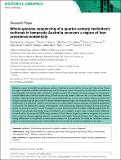Files in this item
Whole-genome sequencing of a quarter-century melioidosis outbreak in temperate Australia uncovers a region of low-prevalence endemicity
Item metadata
| dc.contributor.author | Chapple, Stephanie N. J. | |
| dc.contributor.author | Sarovich, Derek S. | |
| dc.contributor.author | Holden, Matthew T. G. | |
| dc.contributor.author | Peacock, Sharon J. | |
| dc.contributor.author | Buller, Nicky | |
| dc.contributor.author | Golledge, Clayton | |
| dc.contributor.author | Currie, Bart J | |
| dc.contributor.author | Mayo, Mark | |
| dc.contributor.author | Price, Erin P. | |
| dc.date.accessioned | 2016-08-02T10:30:04Z | |
| dc.date.available | 2016-08-02T10:30:04Z | |
| dc.date.issued | 2016-07-11 | |
| dc.identifier | 244697829 | |
| dc.identifier | 2762225b-ff6d-4d48-a806-e7fba8026595 | |
| dc.identifier | 85045993520 | |
| dc.identifier | 000431153900006 | |
| dc.identifier.citation | Chapple , S N J , Sarovich , D S , Holden , M T G , Peacock , S J , Buller , N , Golledge , C , Currie , B J , Mayo , M & Price , E P 2016 , ' Whole-genome sequencing of a quarter-century melioidosis outbreak in temperate Australia uncovers a region of low-prevalence endemicity ' , Microbial Genomics , vol. 2 , no. 7 . https://doi.org/10.1099/mgen.0.000067 | en |
| dc.identifier.issn | 2057-5858 | |
| dc.identifier.other | Bibtex: urn:a88beb39eebe2dbb8a3186d40543016b | |
| dc.identifier.other | ORCID: /0000-0002-4958-2166/work/60196402 | |
| dc.identifier.uri | https://hdl.handle.net/10023/9242 | |
| dc.description | This study was funded by the National Health and Medical Research Council via awards 1046812 and 1098337, and the Wellcome Trust Sanger Institute via award 098051. S.J.P. receives funding from the NIHR Cambridge Biomedical Research Centre. | en |
| dc.description.abstract | Melioidosis, caused by the highly recombinogenic bacterium Burkholderia pseudomallei, is a disease with high mortality. Tracing the origin of melioidosis outbreaks and understanding how the bacterium spreads and persists in the environment are essential to protecting public and veterinary health and reducing mortality associated with outbreaks. We used whole-genome sequencing to compare isolates from a historical quarter-century outbreak that occurred between 1966 and 1991 in the Avon Valley, Western Australia, a region far outside the known range of B. pseudomallei endemicity. All Avon Valley outbreak isolates shared the same multilocus sequence type (ST-284), which has not been identified outside this region. We found substantial genetic diversity among isolates based on a comparison of genome-wide variants, with no clear correlation between genotypes and temporal, geographical or source data. We observed little evidence of recombination in the outbreak strains, indicating that genetic diversity among these isolates has primarily accrued by mutation. Phylogenomic analysis demonstrated that the isolates confidently grouped within the Australian B. pseudomallei clade, thereby ruling out introduction from a melioidosis-endemic region outside Australia. Collectively, our results point to B. pseudomallei ST-284 being present in the Avon Valley for longer than previously recognized, with its persistence and genomic diversity suggesting long-term, low-prevalence endemicity in this temperate region. Our findings provide a concerning demonstration of the potential for environmental persistence of B. pseudomallei far outside the conventional endemic regions. An expected increase in extreme weather events may reactivate latent B. pseudomallei populations in this region. | |
| dc.format.extent | 10 | |
| dc.format.extent | 3704439 | |
| dc.language.iso | eng | |
| dc.relation.ispartof | Microbial Genomics | en |
| dc.subject | Australia | en |
| dc.subject | Evolution | en |
| dc.subject | Melioidosis | en |
| dc.subject | Endemicity | en |
| dc.subject | Burkholderia pseudomallei | en |
| dc.subject | Temperate | en |
| dc.subject | QR Microbiology | en |
| dc.subject | DAS | en |
| dc.subject.lcc | QR | en |
| dc.title | Whole-genome sequencing of a quarter-century melioidosis outbreak in temperate Australia uncovers a region of low-prevalence endemicity | en |
| dc.type | Journal article | en |
| dc.contributor.institution | University of St Andrews. School of Medicine | en |
| dc.contributor.institution | University of St Andrews. Infection Group | en |
| dc.contributor.institution | University of St Andrews. Biomedical Sciences Research Complex | en |
| dc.identifier.doi | 10.1099/mgen.0.000067 | |
| dc.description.status | Peer reviewed | en |
This item appears in the following Collection(s)
Items in the St Andrews Research Repository are protected by copyright, with all rights reserved, unless otherwise indicated.

